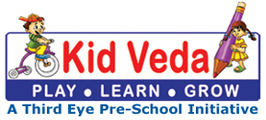Curriculum Design:
To understand our curriculum and methodology let us look at some facts about human brain development:
- 50 % of the ability to learn is developed in the first four years of life.
- Another 30% develops by the age of eight.
This means that during these early years children form the main learning pathways in their brains. Everything we learn latter grows from the patterns established during these years.

According to Dr. Howard Gardner the traditional notion of a single IQ is severely limited. In the past, verbal, logic and math skills were equated with ‘intelligence’, while skills in areas such as art, music or social behavior were seen simply as ‘talents’. In contrast, Dr. Gardner says all areas should be equally valued and be called intelligences.
The theory also suggests that children can become more intelligent in more ways if they are provided with experiences and opportunities that foster all types of intelligence.
At Kid Veda we try to provide an opportunity to develop all the intelligences, so that students can discover the ones they are particularly strong in, and use those in life.
Our methodology helps to culture the body, mind and emotions, and create a sense of belongingness with the world. It helps in preparing children to live with a smile in this ever-changing world by equipping them with all the necessary skills, information and wisdom to be worthy global citizens.
According to Dr Howard Gardener, the traditional notion of a single IQ limits the learning to academics. So to widen the horizon of learning, Our lesson plan follows a methodology, which has been derived after vast research.
The methodology is based on providing opportunities to nurture and explore the 8 types of intelligences:
- LINGUISTIC (dealing with alphabets, writing and speaking)
- LOGICAL (analytical reasoning, numbers)
- VISUAL INTERPRETATION (art activities , drawing and coloring)
- NATURALIST (emotional and environmental needs)
- KINESTHTIC ( a lot of physical activities and outdoor games)
- INTRAPERSONAL (general awareness)
- INTERPERSONAL (interacting with each other)
- MUSICAL (singing, rhymes)
The delivery of the curriculum is based on this methodology which includes planning Class activities, games, designing worksheets or activities, which helps in the development of any of these attributes.
Teaching Methodology:
Happy Learning: At Kid Veda we believe that making learning “happy” for learners is a combined outcome of people, places and activities. By creating a positive and supportive environment for learning we are actively modeling how we would like children to behave. In fact research has proved that we are able to learn when we are in harmony with the people and things in any given educational environment. Being in harmony means feeling safe, feeling valued and not feeling threatened in any manner. If we don’t feel threatened we have a willingness to be vulnerable to be open to new ideas and guidance from others- the ideal learning scenario.
To make learning “Happy” we at Kid Veda focus on three main aspects-









Play - Learn - Grow
Play is serious activity for children. A learning environment that allows maximum opportunities for play is best suited for children’s growth and development. During play children -
|
In the process Play the child
|
